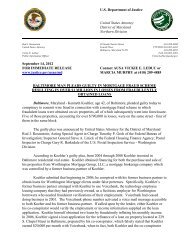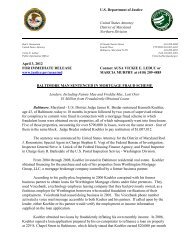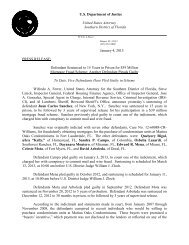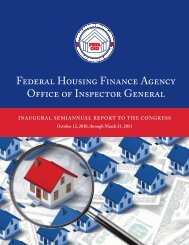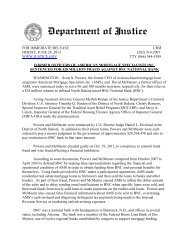FEDERAL
Sixth Semiannual Report to the Congress - Federal Housing ...
Sixth Semiannual Report to the Congress - Federal Housing ...
- No tags were found...
You also want an ePaper? Increase the reach of your titles
YUMPU automatically turns print PDFs into web optimized ePapers that Google loves.
assistance to homeowners and<br />
to use its authority to encourage<br />
mortgage servicers that work with<br />
the enterprises to take advantage<br />
of federal programs to minimize<br />
foreclosures. 177<br />
In partly fulfilling its<br />
EESA mandate to preserve<br />
homeownership, FHFA worked<br />
with Treasury to set up HARP<br />
in 2009. This program allows<br />
borrowers (who might otherwise<br />
not qualify for refinancing)<br />
to take advantage of currently<br />
low mortgage interest rates and<br />
refinance their loans. In general,<br />
the program is geared toward<br />
borrowers who are current on their<br />
mortgage payments and includes<br />
underwater borrowers who owe<br />
more than their homes are worth.<br />
Through March 2013, 2.4 million<br />
homeowners have refinanced<br />
through HARP. 178<br />
Through March<br />
2013, 2.4 million<br />
homeowners<br />
have refinanced<br />
through HARP,<br />
the enterprises<br />
completed<br />
approximately<br />
434,000 HAMP<br />
modifications,<br />
and the<br />
enterprises<br />
made more<br />
Since early 2009, FHFA has<br />
also supported the enterprises’<br />
participation in HAMP. HAMP<br />
is intended to help struggling<br />
homeowners stay in their homes<br />
by reducing their monthly<br />
mortgage payments. To reduce<br />
payments, servicers may modify<br />
their loans by lowering interest<br />
rates, extending the payback periods (e.g., from 30<br />
to 40 years), or forbearing principal (i.e., postponing<br />
collecting a portion of what they are owed). 179<br />
Through March 2013, the enterprises had completed<br />
approximately 434,000 HAMP modifications. In<br />
addition, the enterprises made more than 1.4 million<br />
than 1.4 million<br />
proprietary<br />
modifications<br />
outside of HAMP.<br />
The following minitutorial (see pages 66-67)<br />
highlights loan modification options under<br />
HAMP, HAMP Principal Reduction Alternative<br />
(PRA), and HARP.<br />
proprietary modifications outside<br />
of HAMP during the same<br />
period. 180<br />
FHFA sees its support of mortgage<br />
modification and forbearance<br />
as consistent with both EESA’s<br />
mandate to help homeowners and<br />
HERA’s requirement to safeguard<br />
the enterprises’ assets. 181 However,<br />
questions have arisen concerning<br />
the enterprises’ participation in<br />
programs, such as HAMP, within<br />
Treasury’s wider Making Home<br />
Affordable (MHA) program.<br />
Some critics argue that Treasury<br />
has employed the enterprises<br />
to manage MHA in ways<br />
that jeopardize their financial<br />
interests and has done so without<br />
adequately working with FHFA,<br />
thus potentially compromising<br />
its discretion as conservator and<br />
regulator. 182<br />
In responding to a congressional<br />
request to examine the<br />
controversy, we determined that<br />
FHFA has supported HAMP as<br />
a means to limit the enterprises’<br />
losses by minimizing costly<br />
foreclosures. At the same time, the<br />
agency has shown independence<br />
by prohibiting the enterprises<br />
from participating in other MHA<br />
programs that it viewed as being inconsistent with<br />
their financial soundness. 183<br />
Semiannual Report to the Congress • April 1, 2013–September 30, 2013 65



